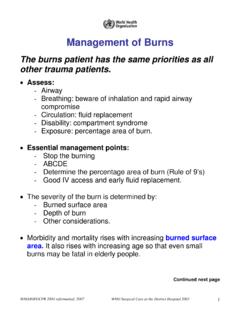Transcription of What are the Symptoms of Type 2 Diabetes?
1 Post-Core: A Closer Look at Type 2 Diabetes What are the Symptoms of Type 2 Diabetes? According to the Centers for Disease Control and Prevention (CDC), there are almost 26 million people in the United States diagnosed with diabetes (2011). The Symptoms of diabetes can vary, range from mild to severe, or Symptoms can even be absent. The most common Symptoms include: Increased thirst Increased hunger Fatigue Increased urination, especially at night Weight loss Blurred vision Sores that do not heal For people with type 2 diabetes, Symptoms generally develop gradually.
2 Many people do not find out they have type 2 diabetes until they develop a complication from the disease, such as aproblems with vision or heart trouble. In some cases, a person can have the disease for many years before it is diagnosed. National Diabetes Prevention Program: Post-Core 1 Post-Core: A Closer Look at Type 2 Diabetes What is Diabetes? In order to describe diabetes, it is important to understand how thebody processes and uses food.
3 Each time we eat food, our bodies go through a process that changes the food into energy that our bodies can use for daily activity. The food we eat is broken down by our bodies into glucose. Glucose is what fuels cells of the body; these cells need energy from glucoseto live. Glucose from the food iscarriedby the blood to cells throughout the body. Glucose, however, is not automatically absorbed by cells. Insulinis required to unlock the cells and allow the glucose to be changed into energy. If there is not enough insulin or if the body does not use insulin properly, (a condition known as insulin resistance), then glucose is not able to get into the cells.
4 As a result, glucose builds up in the bloodstream (causing high blood sugar). There is no cure for diabetes. Properly managing the disease requires lifestyle changes and medication. When diabetes is not controlled, glucose builds up in the blood and can cause damage to vital organs. When diabetes is controlled, complications can often be avoided. There are two types of diabetes. In type 1 diabetes a person s body does not make enough insulin to help move glucose into the cells for energy. In type 2 diabetes a person s body does not use insulin effectively and over time will not make enough insulin.
5 Type 1 diabetes typically happens to people under the age of 30 and cannot be prevented. Type 2 diabetes can be prevented. National Diabetes Prevention Program: Post-Core 2 Post-Core: A Closer Look at Type 2 Diabetes How is Diabetes Diagnosed? Testing for diabetes and prediabetes should be done by a health care provider. There are currently three tests that can be done. Fasting plasma glucose (FPG) This test measures for impaired fasting glucose (IFG); a person s blood glucose is measured first thing in the morning following an eight-hour fast.
6 Fasting blood glucose levels: Normal: below 100 mg/dl (milligrams per deciliter) Prediabetes: between 100 and 125 mg/dl Diabetes:126 mg/dl or above Oral glucose tolerance test (OGTT) This test measures for impaired glucose tolerance (IGT). A person s blood glucose is measured after an eight-hour fast and again two hours after drinking a glucose-rich solution. Levels measured two hours after drinking the solution: Normal: below 140 mg/dl Prediabetes: 140-199 mg/dl Diabetes: 200 mg/dl or above Glycated Hemoglobin (HbA1c) This blood test measures a person s average glucose level over aeight to twelve week period before the test is given.
7 Blood is drawn from a person s arm; fasting is not necessary. HbA1c levels: Normal: HbA1c below Prediabetes: HbA1c Diabetes: HbA1c and above National Diabetes Prevention Program: Post-Core 3 Post-Core: A Closer Look at Type 2 Diabetes What Should My Medical Care be Like? If you are diagnosed with diabetes, you and your doctor will work out a diabetescare plan and build a team of health care providers to give you the care and information that you will need to safely and effectively manage the disease.
8 Primary Care Physician Your first visit with your physician would include a physical examination, medical history, and blood and urine tests. Follow-up visits to your physician shouldhappenregularly. Registered Dietitian It would be important for you to meet with a registered dietitian who is trained in diabetes management. The dietitian would teach you about how different foods affect your blood glucose levels and get you started on a healthy eating plan (if you aren t already maintaining those practices).
9 Diabetes Educator A diabetes educator is trained to help people with diabetes learn to self-manage their disease. A diabetes educator can be a nurse, dietitian, pharmacist, or other health care provider. Your doctor would give you a referral for a diabetes education visit. Specialists Diabetes can cause problems with blood vessels and nerves. This can lead to problems with blood flow to the heart, eyes, kidneys, legs, and other doctor would help you identify what kind of specialists you need to see.
10 YOU You would be the most important person in managing your diabetes. Diabetes management and control starts with proper self-care. You should seek every resource to learn as much as you can about your diabetes. Knowledge is power! National Diabetes Prevention Program: Post-Core 4 Post-Core: A Closer Look at Type 2 Diabetes National Diabetes Prevention Program: Post-Core 5 How Would My Life at Home Change? The cornerstone of diabetes care is managing your daily lifestyle.












